人教版(2019)必修 第二册Unit 3 The internet>Reading for Writing课件(共18张PPT)
文档属性
| 名称 | 人教版(2019)必修 第二册Unit 3 The internet>Reading for Writing课件(共18张PPT) |
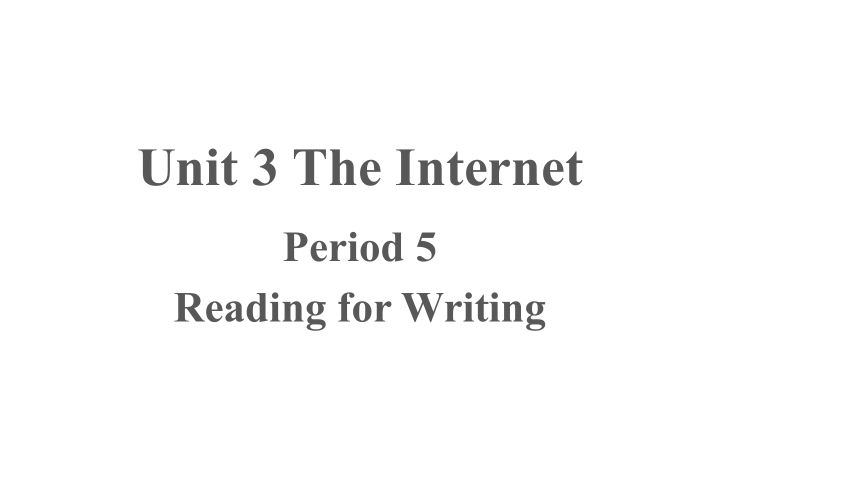
|
|
| 格式 | pptx | ||
| 文件大小 | 3.6MB | ||
| 资源类型 | 教案 | ||
| 版本资源 | 人教版(2019) | ||
| 科目 | 英语 | ||
| 更新时间 | 2024-04-17 07:56:35 | ||
图片预览

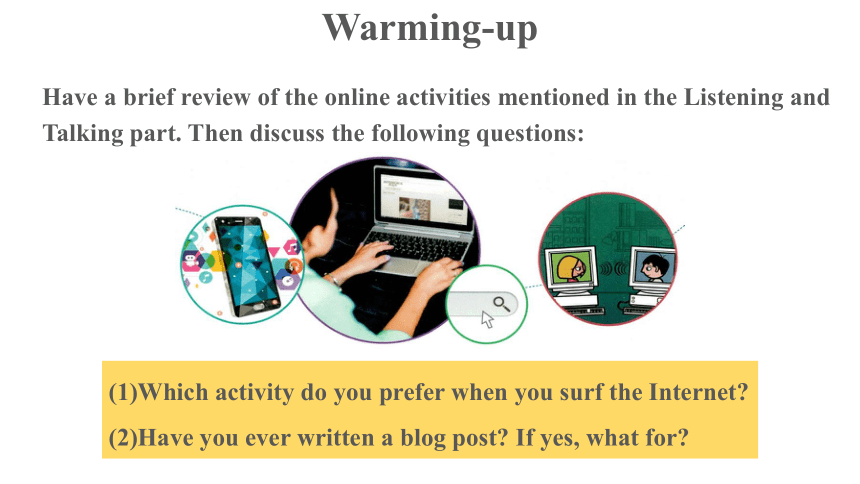

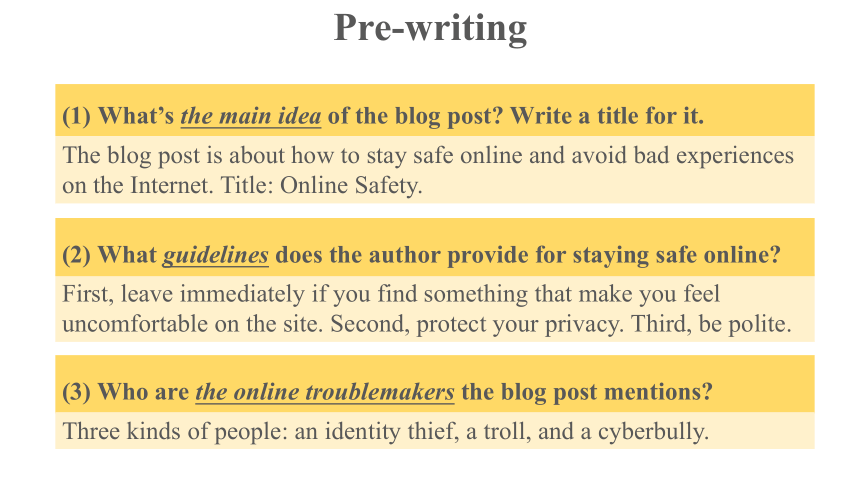
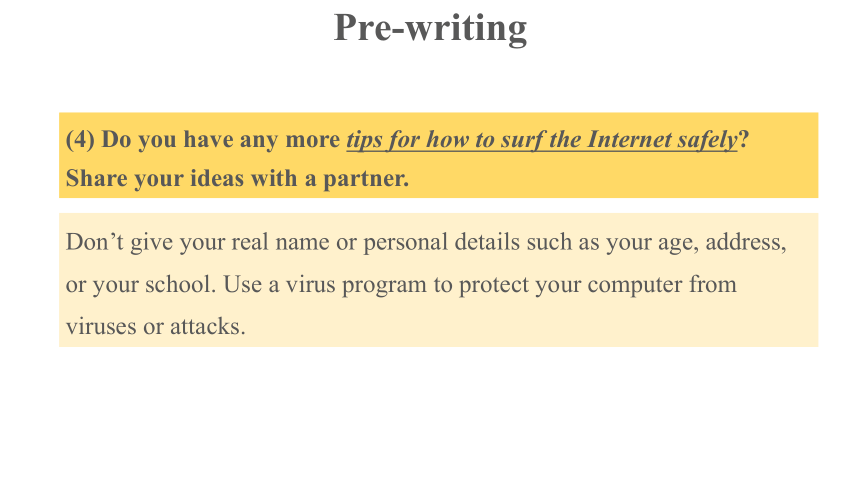
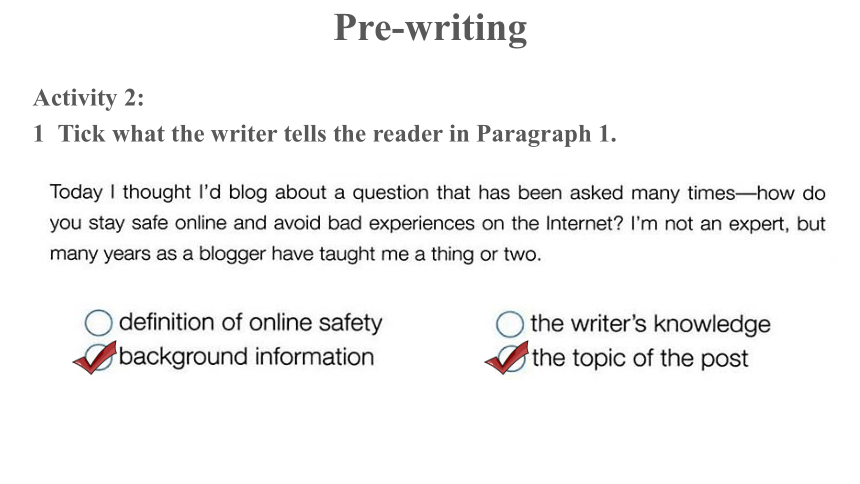
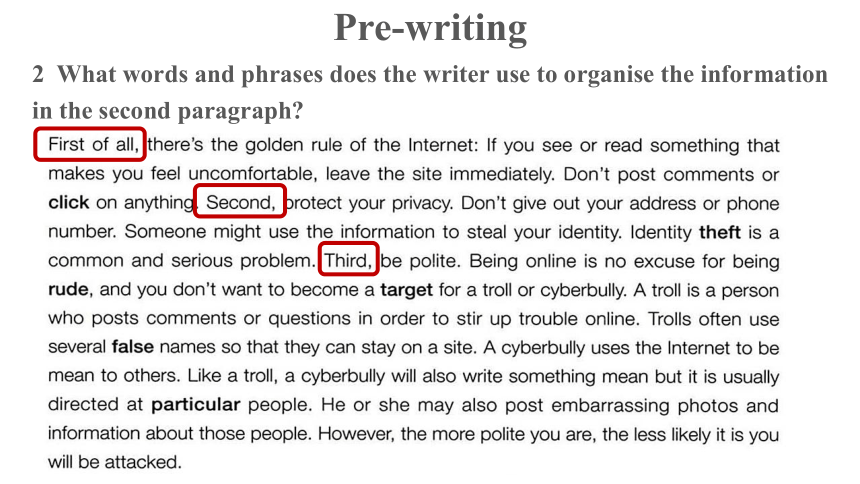
文档简介
(共18张PPT)
Unit 3 The Internet
Period 5
Reading for Writing
Warming-up
Have a brief review of the online activities mentioned in the Listening and Talking part. Then discuss the following questions:
(1)Which activity do you prefer when you surf the Internet
(2)Have you ever written a blog post If yes, what for
Pre-writing
(1) What’s the main idea of the blog post Write a title for it.
(2) What guidelines does the author provide for staying safe online
(3) Who are the online troublemakers the blog post mentions
(4) Do you have any more tips for how to surf the Internet safely Share your ideas with a partner.
Activity 1:
Work on Activity 1. Read the blog post and answer the questions.
Pre-writing
(1) What’s the main idea of the blog post Write a title for it.
The blog post is about how to stay safe online and avoid bad experiences on the Internet. Title: Online Safety.
First, leave immediately if you find something that make you feel uncomfortable on the site. Second, protect your privacy. Third, be polite.
(3) Who are the online troublemakers the blog post mentions
Three kinds of people: an identity thief, a troll, and a cyberbully.
(2) What guidelines does the author provide for staying safe online
Pre-writing
(4) Do you have any more tips for how to surf the Internet safely Share your ideas with a partner.
Don’t give your real name or personal details such as your age, address, or your school. Use a virus program to protect your computer from viruses or attacks.
Pre-writing
Activity 2:
1 Tick what the writer tells the reader in Paragraph 1.
Pre-writing
2 What words and phrases does the writer use to organise the information in the second paragraph
3 What new words are explained in the text, and how
Troll and cyberbully.
Use simple words and an explanation sentence to define “troll”.
Define “cyberbully” by comparing it with “troll”.
4 How does the writer end the post
By asking for comments.
Pre-writing
Pre-writing
5 Discussion: Did you have similar experiences How did you deal with these problems
While-writing
Activity 3:
Step 1: Choose one of the topics and use the notes to draft your blog post.
While-writing
Step 2: Organise your draft.
While-writing
Activity 4:
Exchange drafts with a partner. Use the checklist to help your partners revise his/her draft.
Post-writing
Introduction
Hello everyone. I’m a senior high school student. Today I want to blog about something that I think is very important. Unfortunately, I know about this topic well because I made a silly mistake. That was to make my email password “password123”!
Sample Version
Post-writing
Body
About six months ago, someone hacked my email account. That means they found out my password, then tried to use my account to take money from me and sent viruses to all my contacts! Luckily my friend told me when she got a strange email from me, so I changed my password immediately. I read about how to make a good password. A good one should have a mixture of both upper case (large capital) letters and lower case (small) letters, numbers, and other characters. It also should not be a name or date or anything someone can guess. It should be completely random, that is, it shouldn’t make sense! Although it can be hard to remember lots of complicated passwords, it is worth it! These days you can also use a password manager. This is a special program that helps you manage passwords for all your different accounts.
Post-writing
Ending
Although I hope nothing similar has happened to my readers, please comment if you have had a similar experience or if you have any more good ideas about making your passwords super safe! Catch you later!
Post-writing
Show time!
Assignment
Read 3 students’ revised drafts, and give your comments on each of them.
Goodbye!
Unit 3 The Internet
Period 5
Reading for Writing
Warming-up
Have a brief review of the online activities mentioned in the Listening and Talking part. Then discuss the following questions:
(1)Which activity do you prefer when you surf the Internet
(2)Have you ever written a blog post If yes, what for
Pre-writing
(1) What’s the main idea of the blog post Write a title for it.
(2) What guidelines does the author provide for staying safe online
(3) Who are the online troublemakers the blog post mentions
(4) Do you have any more tips for how to surf the Internet safely Share your ideas with a partner.
Activity 1:
Work on Activity 1. Read the blog post and answer the questions.
Pre-writing
(1) What’s the main idea of the blog post Write a title for it.
The blog post is about how to stay safe online and avoid bad experiences on the Internet. Title: Online Safety.
First, leave immediately if you find something that make you feel uncomfortable on the site. Second, protect your privacy. Third, be polite.
(3) Who are the online troublemakers the blog post mentions
Three kinds of people: an identity thief, a troll, and a cyberbully.
(2) What guidelines does the author provide for staying safe online
Pre-writing
(4) Do you have any more tips for how to surf the Internet safely Share your ideas with a partner.
Don’t give your real name or personal details such as your age, address, or your school. Use a virus program to protect your computer from viruses or attacks.
Pre-writing
Activity 2:
1 Tick what the writer tells the reader in Paragraph 1.
Pre-writing
2 What words and phrases does the writer use to organise the information in the second paragraph
3 What new words are explained in the text, and how
Troll and cyberbully.
Use simple words and an explanation sentence to define “troll”.
Define “cyberbully” by comparing it with “troll”.
4 How does the writer end the post
By asking for comments.
Pre-writing
Pre-writing
5 Discussion: Did you have similar experiences How did you deal with these problems
While-writing
Activity 3:
Step 1: Choose one of the topics and use the notes to draft your blog post.
While-writing
Step 2: Organise your draft.
While-writing
Activity 4:
Exchange drafts with a partner. Use the checklist to help your partners revise his/her draft.
Post-writing
Introduction
Hello everyone. I’m a senior high school student. Today I want to blog about something that I think is very important. Unfortunately, I know about this topic well because I made a silly mistake. That was to make my email password “password123”!
Sample Version
Post-writing
Body
About six months ago, someone hacked my email account. That means they found out my password, then tried to use my account to take money from me and sent viruses to all my contacts! Luckily my friend told me when she got a strange email from me, so I changed my password immediately. I read about how to make a good password. A good one should have a mixture of both upper case (large capital) letters and lower case (small) letters, numbers, and other characters. It also should not be a name or date or anything someone can guess. It should be completely random, that is, it shouldn’t make sense! Although it can be hard to remember lots of complicated passwords, it is worth it! These days you can also use a password manager. This is a special program that helps you manage passwords for all your different accounts.
Post-writing
Ending
Although I hope nothing similar has happened to my readers, please comment if you have had a similar experience or if you have any more good ideas about making your passwords super safe! Catch you later!
Post-writing
Show time!
Assignment
Read 3 students’ revised drafts, and give your comments on each of them.
Goodbye!
